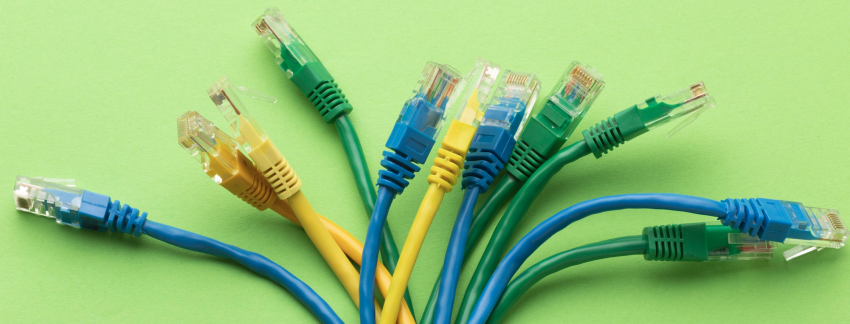- Ethernet is a collection of network protocols/standards
- Ethernet == IEEE 802.3 → transmission over cables (copper or fibre-optic)
- Wi-Fi == IEEE 802.11 → wireless transmission
Connections and Speed
- Bit: 0 or 1; 1 kilobit (kb) = 1000 bits (not bytes!)
- Speed is measured in bits per second (Kbps, Mbps, Gbps)
- Data size is measured in bytes
Ethernet Standards (Copper)
IEEE 802.3i, 802.3u, 802.3ab, 802.3an – standards with different data transmission speeds and names
| Speed | Name (common) | IEEE (standard) | Name (informal) |
|---|---|---|---|
| 10 Mbps | Ethernet | 802.3i | 10BASE-T |
| 100 Mbps | Fast Ethernet | 802.3u | 100BASE-T |
| 1 Gbps | Gigabit Ethernet | 802.3ab | 1000BASE-T |
| 10 Gbps | 10 Gig Ethernet | 802.3an | 10GBASE-T |
- Maximum length of twisted-pair cables: 100 m
- RJ-45 (Registered Jack) is used at the end of copper Ethernet cables
UTP (Unshielded Twisted Pair)
- 10BASE-T and 100BASE-T use 2 pairs (4 wires)
- 1000BASE-T and 10GBASE-T use 4 pairs (8 wires), each pair is bidirectional
Full-Duplex Transmission
- Both devices can send and receive data at the same time (on separate wires → no collisions)
- Example: pins 1 & 2 Tx and pins 3 & 6 Rx
Pin Usage
- Router, Firewall, PC → transmit on pins 1 & 2, receive on pins 3 & 6 (straight-through cable)
- Switch → transmit on pins 3 & 6, receive on pins 1 & 2 (crossover cable)
Auto MDI-X
- Allows automatic detection of which pins are used for transmitting and which for receiving
Ethernet Standards (Fibre-Optic)
IEEE 802.3z, 802.3ae – standards with different data transmission speeds and names
| Name (informal) | IEEE (standard) | Speed | Cable type | Max Length |
|---|---|---|---|---|
| 1000BASE-LX | 802.3z | 1 Gbps | Multi/Single | 550m / 5km |
| 10GBASE-SR | 802.3ae | 10 Gbps | Multimode | 400m |
| 10GBASE-LR | 802.3ae | 10 Gbps | Single-Mode | 10 km |
| 10GBASE-ER | 802.3ae | 10 Gbps | Single-Mode | 30 km |
- Maximum fibre-optic length: ~30 km (single-mode), ~550 m (multimode)
SFP Transceiver (Small Form-Factor Pluggable)
- An SFP slot allows connection of fibre-optic cables (like RJ-45, but for fibre-optic)
- Fibre-optic cables always use 2 separate cables: one for transmitting, one for receiving data
- Copper cables use separate wires within the same cable for transmitting and receiving
Fibre-Optic Cable Structure (4 layers)
- Fibre glass core
- Cladding (reflects light)
- Protective buffer
- Outer jacket
Types of Fibre-Optic Cables
- Single-mode – narrower, single angle of light waves, more expensive (laser-based transmitter), longer distance
- Multimode – wider, multiple angles of light waves, cheaper (LED-based transmitter), shorter distance
📌 These are personal study notes. Please read the full disclaimer for more information.
Category: CCNA
